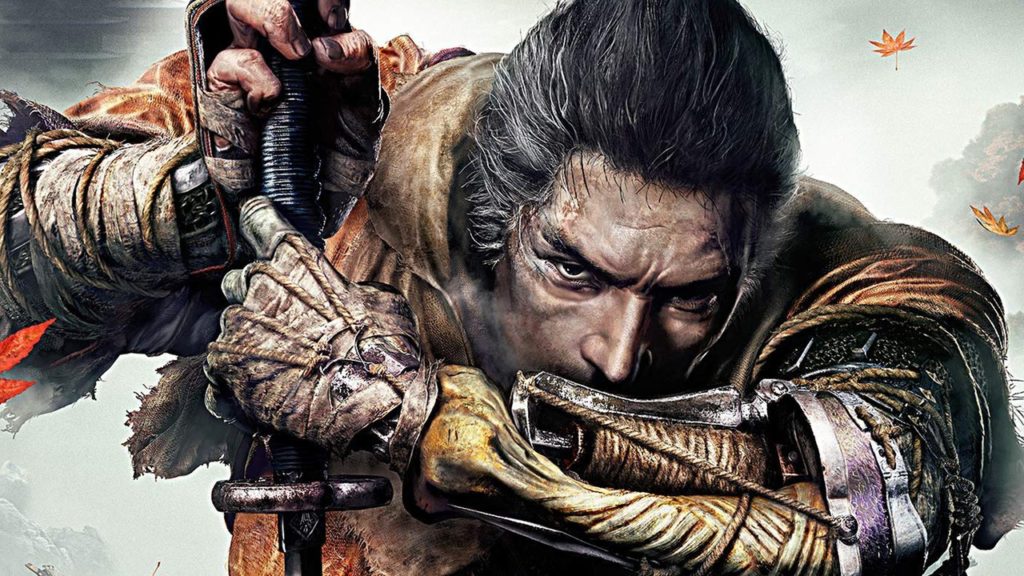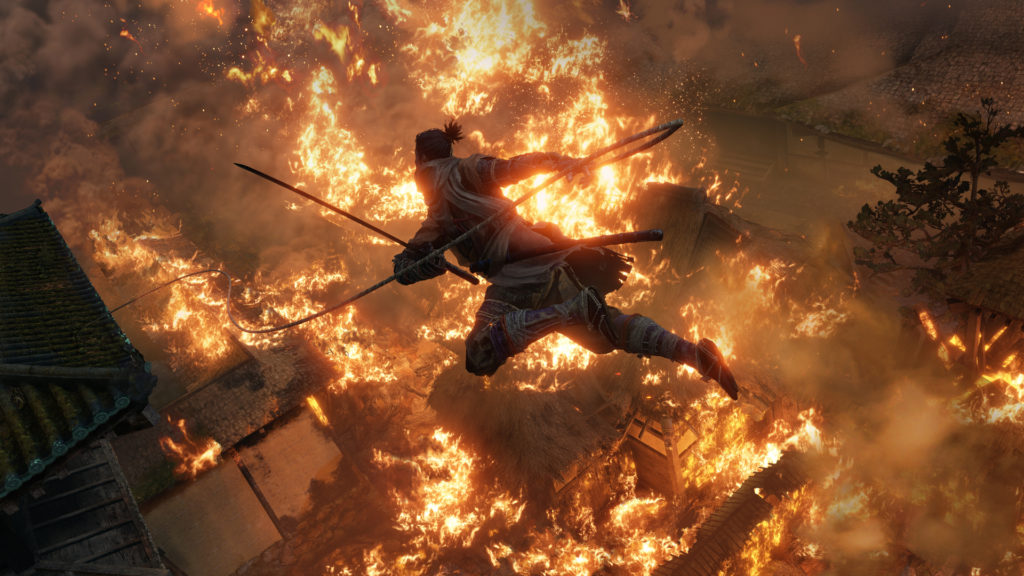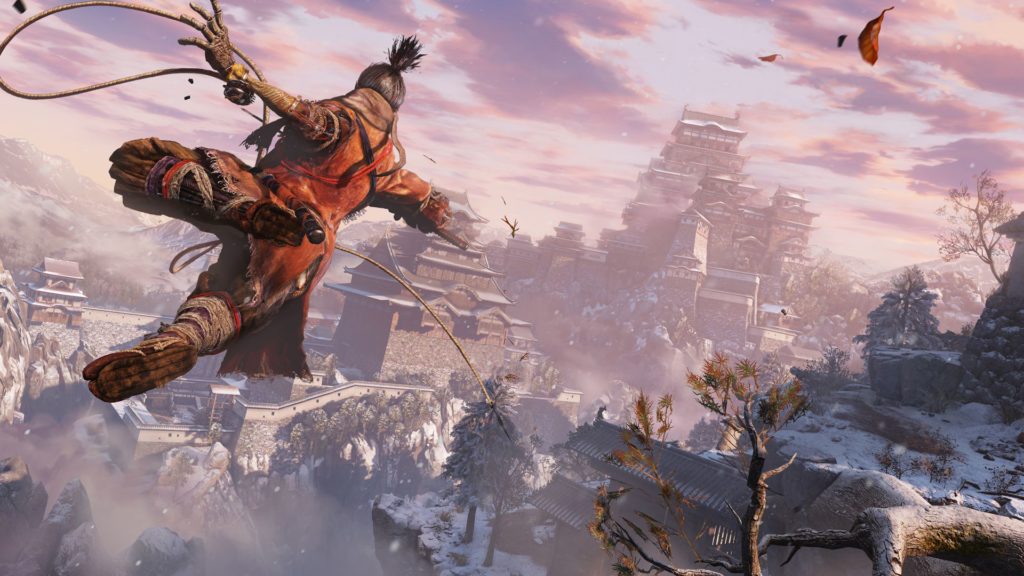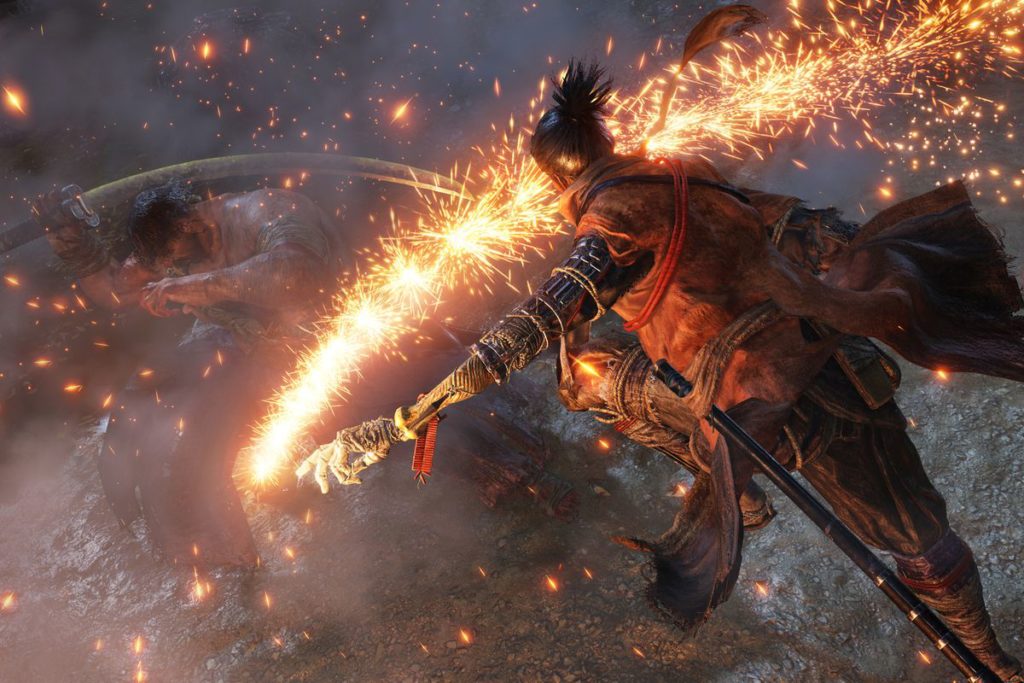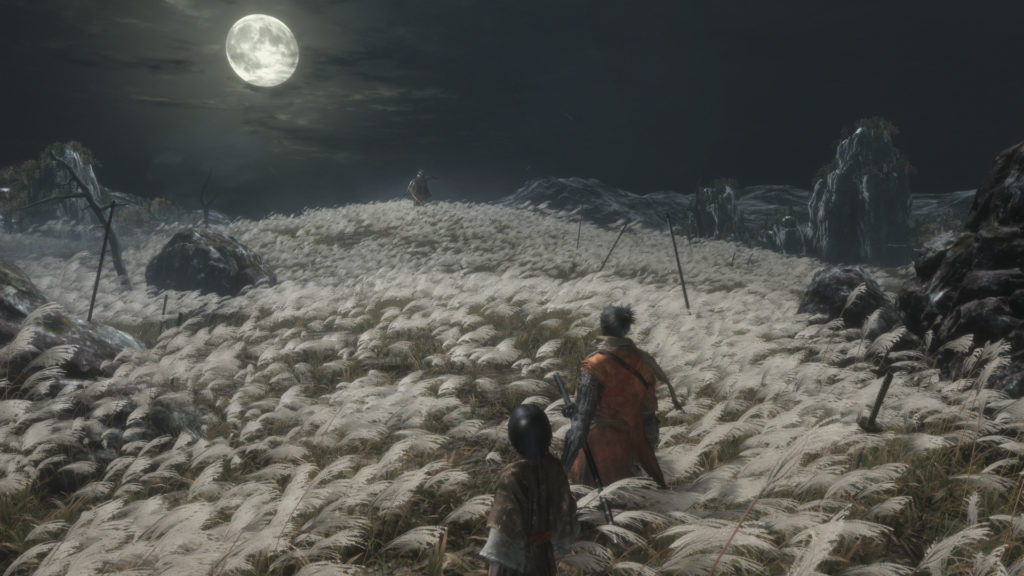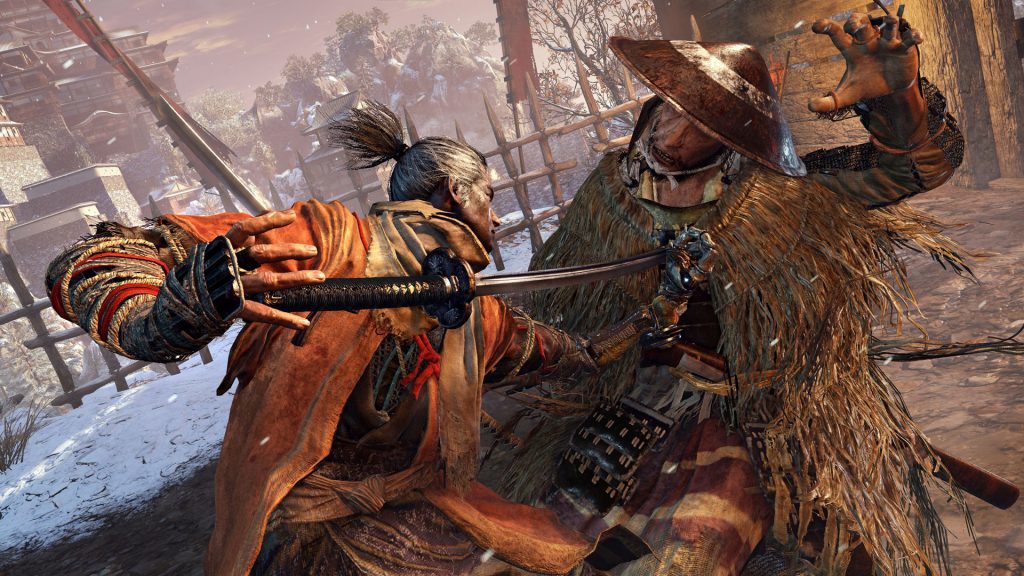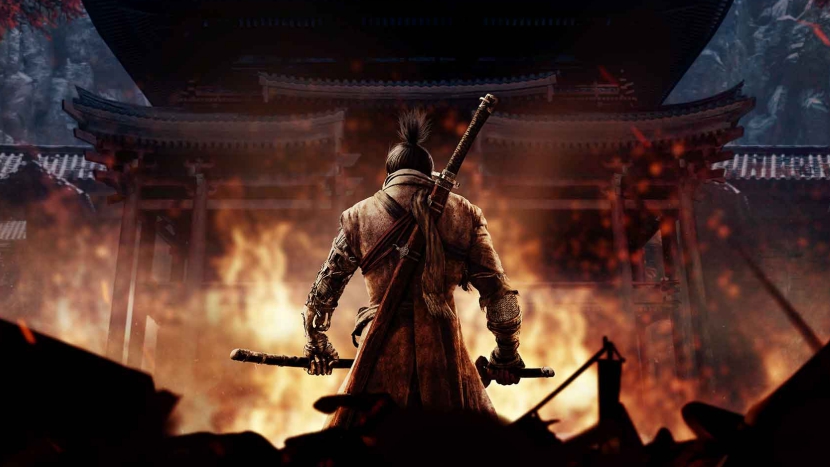After all the multiplayer games, I’m glad to see that the single player games haven’t been extinct. Then again, Sekiro: Shadows die twice isn’t your brainless single player story as you might think, it’s from the creators of the Dark Souls franchise, so you can easily figure out where this game should be heading. Indeed, it’s a single player game where your frustration reaches new levels, levels you didn’t even expect to have. Let’s dive right in!
FromSoftware leaves the world of the Ashen One behind and takes on the Dark Souls series but with a more Eastern approach. If you combine the mechanics of Dark Souls and the atmosphere of the Japanese Mythology, you’re left with Sekiro: Shadows Die Twice and it’s a keeper. Within the world of Sekiro, you take on the role of a Shinobi warrior (ninja) that got the name Sekiro, which means One-Armed Wolf. The translation of the name does make sense, as your protagonist starts off the game with a sculptured “bionic” arm that’ll help the Shinobi warrior in his dark adventure to come. As a recognized Shinobi, it’s your job to fulfill all of your master’s wishes and to keep him/ her safe. You’re assigned to a Divine child which carries the corrupted Dragonblood within his veins, but as a protector, this bloodline is also connected to you which gives you access to tremendous power, namely Immortality. However, carrying this Dragonblood don’t all come with only advantages, it’s a blessing and a curse. In your quest to search for your master, different dangers will cross your path but you will do anything it takes, to save the child and get redemption.
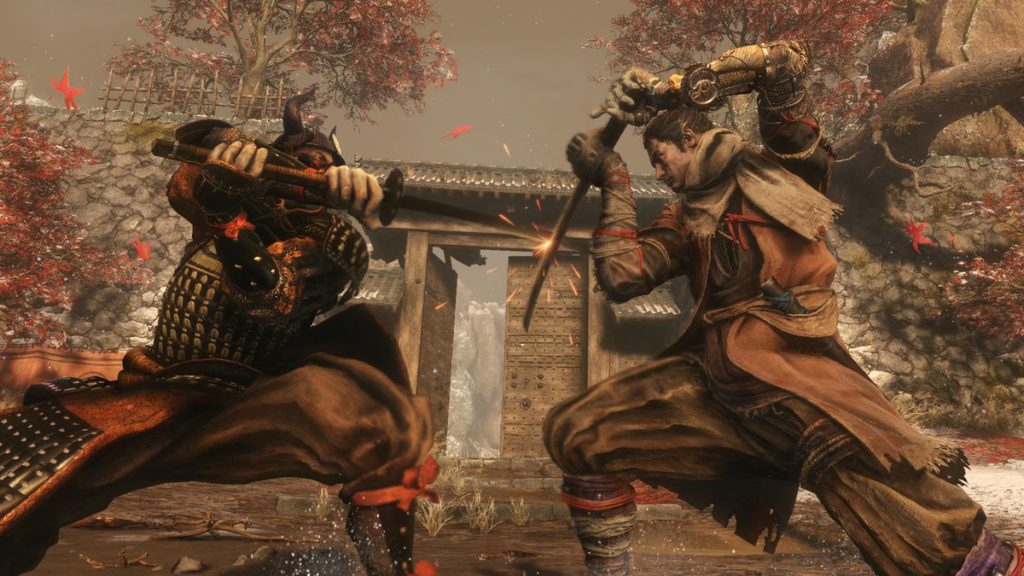
To keep some key information classified, the storyline is pretty clear and it will take you around 30 hours to finish the game. However, there’s still the opportunity to replay the game, as the ending of Sekiro leaves you with a game + mode that’ll let you replay the game with all of your gained skill points and items intact. This mode allows different playthroughs of the game which will allow you to discover 3 of the other endings.
“It’s an interesting mechanic that changes these types of games for the better.”
The game itself looks amazing, especially with this type of setting. Sekiro’s graphical design of the world doesn’t disappoint either, even when you’re looking at the variety of landscapes. The game takes you to different areas that can stand on their own but eventually melt into this big world, at least that’s the way you’re feeling when you’re playing the game. The world is filled with areas to explore and enemies to fight, however even though the enemies group up and starts running towards you, I can’t help but feel that the world does need some “filling”. Some places even seem too small, especially when you’re traversing the areas at high speed with your grappling hook and running skill. It’s because of this mobility that the beauty of some areas go right past you and don’t even get the time to appreciate. Still, there’s a lot of variation between the environments and the design of these places are very keen for the eyes, that builds up towards a great atmosphere. I do feel like the world doesn’t offer a lot of lore extras. Everything’s told during the storyline and without “lore gaps”, people may not find “exploring” worth the time. However, the characters you meet, offer an interesting backstory that’ll definitely keep your interests toward the story up.
Talking about some of the mechanics of Sekiro, the game looks a lot like the Dark Souls franchise which sounds obvious since the developers are the same. However, there’s one mechanic that’s fairly new and it does shape the game into something different. Sekiro’s arm offers you the ability to grapple certain points in the environment which may help you to get a bit more advantage over your enemies. Grappling to higher places gives you a great overview which will help you with the planning of your battle plan but it also gives you a lot more options, especially when you’re the more stealth type of player. The use of the grappling hook also adds up to the tempo because it helps you with traversing to the other side but it can also be used to tackle some bigger enemies. It’s an interesting mechanic that changes these types of games for the better.
These types of games are “all work, no play”.
I used the grappling hook mostly to scout ahead and assassinate the lower level enemies. Thinning out the horde of enemies should be a priority when you’re planning to attack a bigger boss. The moment the enemies overrun you, death will be just around the corner. Also, scouting ahead and using the verticality helps you with gathering information as some enemies open up the opportunity to eavesdrop which eventually gives more information about the activities around the battleground. Taking advantage of this type of strategy ( scouting around, taking out the lower level enemies) rewards the casual player but it can become time-consuming as well, especially if you’re approach doesn’t work the first time. These types of games reward the people that take their time to investigate the area and adapt, but some rushers will love the adrenaline injection because of the game’s high stakes. These types of games are about “all work, no play”.
Talking about these high stakes, the game’s definitely tough and challenging. It’s the kind of game that will raise your frustration levels to new heights but it’s also the kind of game that challenges you to think out of the box. The game confronts you with instant-kill bosses and if you’re not thinking further, your death will be the first of many. You do need to take your time and plan your assassination. Use the items and your skills to form a devastating combo that’ll bring the cup home. Fortunately for us, the game doesn’t stop after your death. After death, there’s the option to resurrect or to die. If you choose to die, you’ll be teleported to the latest idol and you’ll lose experience points. Not only do you lose experience points, but also half of your money. It’s good to know that all your items are being kept, even after death. After death, it’s all about reliving the moment, recalibrate and getting the win. However, there’s also the option to resurrect and give the current battle another try. This might be the right way to go when you’re having your enemy on the edge of that cliff, but the resurrection option isn’t always in your favor. Resurrecting seems tempting but you’ll have to consider the fact that the ability to regain 30 percent of your experience points after a certain death, can be lowered by “Dragonrot”. “Dragonrot” is an item that lowers this percentage and even though the chances to get this Dragonrot is random, it all has to do with the number of resurrections you’re initiating. The more resurrections you perform, the higher the chances are, that an item called “Dragonrot” will drop. It also not only affects you as a player but also the NPC’s around you. When the NPC’s around you are infected with Dragonrot, conversations or merchants will stop until you find a cure and even when you find a cure, it’s a very limited cure. So consider each death carefully, because “Dragonrot” can become annoying very quickly.
The combat mechanics also differ from Dark Souls. Where “passive Dark Souls” players shine, will be the deathblow for “passive Sekiro” players. There’s no way a passive player will cross Sekiro’s finish line. Dark Souls had a system where strength and agility played an important role, and even though Sekiro has some of the same elements weaved into its gameplay, there are still some major differences to consider. Each enemy and of course you as the player, have a stamina bar. This stamina bar has to be filled to break an enemy’s posture. When the enemy’s posture is filled, you can deliver a deathblow. A deathblow often means “instant kill” but some bigger enemies need more deathblows than others. I feel like Sekiro is a game where you’re constantly weighing the situation, weighing between an active and a more passive posture. It’s also a game that’s filled with QTE events but you’re just not seeing these “moments” appear on screen which makes the game challenging but also satisfying when you can deliver the final deathblow.
“The mind is your weapon.”
The game’s combat mechanics also offer different items that’ll help Sekiro’s battle along the way, especially in combination with the extended options of Sekiro’s arm prosthetic. His arm can be upgraded with different items that can turn the tide quicker than you think. These skills use idols which can be bought with money or found on the battlefield. There are also “secret techniques” that Sekiro can use to gain the advantage but these techniques can’t always be used. These techniques are only helpful in certain situations and it’s up to you, to figure out the right moment. There’s also the option to power up some physical attributes but the game’s combat mechanics are mostly built on blocking, sidestepping, jumping over sweeps and not getting your ass kicked. It’s challenging because you have to investigate the enemy’s movement and respond to it. If you’re not blocking at the right moment, the battle can quickly become lost. I do have to say that this system feels more fluent than their previous series. Sekiro is all about fine-tuning and honing your skills until you’re ready to face the next enemy. There are no extra armor sets you can buy or upgraded versions of your protagonist’s main weapon. The mind is your weapon.
Each boss in Sekiro needs another tactic. Figure it out, learn his/ her moves, die a couple of times and beat your opponent. Sekiro is a single player experience, so there’s no help from outside the digital world. Some bosses can be tackled with an extra NPC but they don’t do a lot of damage. You’ll probably use your fighting buddies as decoys instead of smashing Hulks. Most of the bosses have a certain attack pattern and it can easily be recognized but it’s up to the player to keep his/ her head in the game because one mistake is fatal and as we already know, death may not be final but it still important to consider your life after. Some bosses are also a lot easier because the game offers you different ways to approach them, some bosses are a lot more difficult because they’ll spam different attacks towards you and you’ll have to maintain your awareness to find an opening so you could strike them. It sounds challenging which it is, but the fall of some of these enemies will give you a boost of positive energy. The bigger they are, the higher they fall. If Sekiro would be a movie, it would be a combination of Tom Cruises’ Last Samurai and Edge of Tomorrow. Expect to see different bosses and be open for anything.
Technically, the game is okay. Most of the time, you’ll get a constant 60 FPS while you’re playing on the PS4 Pro but there are some chapters within the game that asked a lot of my PS4 Pro and a lower FPS became noticeable. However, these situations were very scarce and didn’t influence my gameplay experience. I did have some troubles with the camera, I often would lock on to my enemies and get ready for an assassination… However, I often find myself going in a totally different direction that wasn’t nearly as I was intending. It’s because the enemy wasn’t showing on my screen and therefore wasn’t locking on. The movement controls also felt a bit clunky but then again, maybe I was just so frustrated with an enemy at that moment that I couldn’t blame myself for my own miserable defeat. Who will tell? There’s always two sides of a story…
Conclusion:
This game is a no-brainer if you’re into Bloodbourne and Dark Souls. Sekiro is quite the same but just with a different setting and another way to approach your enemies. This time, stealth can really be a thing and turn the tides into your favor. The combat mechanics are fluent but it does take some time to get used to, especially when you have to consider lots of QTE moments to be successful. Sekiro is gorgeous looking and has a decent story to keep your interest for sure.

